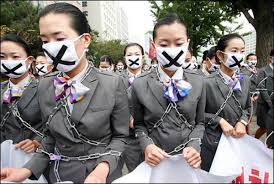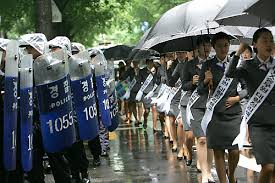
KTX women workers on strike
In 2004, South Korea launched its national bullet train, the KTX. KTX advertised to hire women train attendants. Close to 5000 women applied. KTX hired 351, all in their 20’s. The women were hired on a two year contract. The women were told they would become `regular’ employees at the end of the two years. These jobs were considered dream jobs. The women were highly educated; the jobs were secure, well paying, government jobs. What could go wrong? Everything, and predictably so. After a year, the government launched a privatization program. Women were told they were to be permanently outsource. They would be permanently irregular workers. They could still be called “the Flowers of KTX”, however. In 2006, male and female workers walked off the job. Four days later, the men returned. Twelve years later, on July 21, the women won their victory! On July 21, the Korean Railroad Corporation, KORAIL, said it would reinstate all the workers. One of the strikers, Oh Mi-seon, commented, “The ‘time of struggle’ isn’t over yet.”
The story of the South Korean railway workers’ organizing has at least three major strands. First, there’s the ongoing, intense women workers’ organizing campaigns, lasting twelve years. Women workers organized rallies, sit-ins, occupations, tent cities, and more. Since January 2007, KTX union leaders have conducted a sit-in at Seoul’s central train station. The women workers knew that they were right. They knew that, despite the numbers actually working on the trains, women made up only 5% of KORAIL’s regular employees. They knew that no one can be a permanent `irregular’ employee, and they knew that that particular destiny was slotted for women workers.
Second, the women workers went to court. IN 2008, the women filed a lawsuit. They won in 2009. KORAIL appealed. In 2011, at the appeals level, the women workers won again. KORAIL appealed again. In 2015, the Supreme Court ruled in favor of KORAIL. But it didn’t end there. Since 2015, the women workers, while continuing their demonstrations and other actions, argued that something was fishy about the Supreme Court decision. At the end of May, they were proven right, when documents revealed that former Supreme Court Justice Yang Sung-tae had colluded with former president Park Geun-hye and twisted the law to benefit KORAIL. With that, the women threatened to storm the Supreme Court. Two months later, KORAIL caved.
There is a third strand. When the Supreme Court issued its ruling, in 2015, KORAIL attacked the women workers. KORAIL went to court, insisting that each of the women had to “repay” the company the equivalent of $76,000. In March 2016, a 36-year-old woman worker, only identified as Ms. Park, committed suicide. In every demonstration, press conference, action, Ms. Park is remembered, invoked, conjured. Ms. Park left a note for her 3-year-old daughter: “I am sorry, my baby. All I can leave with you is debt.” When Kim Seung-ha, head of the Korean Railway Workers Union, heard of the agreement with KORAIL, she responded, “I want to tell the friend who couldn’t be here with us for this joyous moment that we were right, we were justified.” Oh Mi-seon added, “I plan to keep battling until the truth comes to light – if only to restore the reputation of the friend I lost.”
Militant women made this happen. Militant women rejected being rendered irregular, precarious, inferior, vulnerable, weak. They withstood and transformed, and today, they are taking the struggle forward, inside the spaces of work and labor, and onto the trains. After twelve years, Korean women workers plan to keep battling until the truth comes to light. The struggle continues.

(Photo Credit: Minplus)